Mirror As Inspiration In The Creation Of Artworks
Abstract
Every artist has the goal of creating works of art that cannot be separated from the spiritual feelings experienced daily. The creative process of creating this work of art is initiated from the mirror which will be explored in the work of art. The method used is descriptive qualitative study and experimental method. The problem in this creation process is how the phenomenon that occurs when humans feel unhappy in their inner life so that they feel depressed, even judged between individuals, both physically and non-physically. The result of this creation process is a puzzle arrangement which is a metaphor for the results of reflection as well as the spiritual relationship of the soul with the body that has been experienced in living and contemplating life. The message conveyed through this work is that humans must understand each other.
Setiap seniman memiliki tujuan menciptakan karya seni yang tidak lepas dari perasaan spiritual yang dialami sehari-hari. Proses kreatif penciptaan karya seni ini digagas dari cermin yang akan dieksplorasikan pada karya seni. Metode yang dipergunakan adalah studi metode deskriptif kualitatif dan metode eksperimental. Permasalahan dalam proses penciptaan ini bagaimana fenomena yang terjadi ketika manusia merasakan perasaan tidak bahagia dalam kehidupan batinnya sehingga merasa tertekan, bahkan dinilai antar individu, baik secara fisik maupun non fisik. Hasil dari proses penciptaan ini adalah susunan puzzle yang merupakan metafora dari dari hasil refleksi sebagaimana hubungan spiritual jiwa dengan tubuh yang telah berpengalaman dalam penjalanan hidup dan perenungan hidup. Pesan yang disampaikan melalui karya ini adalah manusia harus saling memahami antara satu dengan lainnya
Keywords
Full Text:
PDFReferences
Andono, & Rispul. (2012). DALAM KARYA SENI KRIYA KONTEMPORER. 59-80.
Creswell, J. W. (2014). Penelitian Kualitatif dan Desain Riset (S. Z. Qudsy (ed.); 3 ed.). Pustaka Pelajar.
Dewantara, A. W. (2017). Filsafat Moral: Pergumulan Etis Keseharian Hidup Manusia (Marcell (ed.); 4 ed.). PT Kanisius.
Dillistone, F. . (2002). The Power of Symbols (6 ed.). Kanisius. https://books.google.co.id/books?id=JaEkGxauULwC&pg=PA81&lpg=PA81&dq=Hidup+manusia+adalah+sebuah+proses+perjalanan+tentang+apa+yang+sudah,+sedang,+dan+akan+dilakukan+oleh+manusia.&source=bl&ots=-V6sHUSj5g&sig=ACfU3U1Pd6QpM74bmOe4Z2JK9zIvr2M1sw&hl=en&sa=X&
Pandanwangi, A. (2015). Representasi “Teks Budaya Sunda†Menjadi Teks Visual Dalam Karya Seni Rupa Instalasi. Seminar Nasional Fakultas Seni Rupa dan Desain Universitas Tarumanagara 2015. Visual Art and Design, Past, Present, and Future, 1-6. http://repository.maranatha.edu/20450/1/Ariesa_Representasi Teks Budaya Sunda.pdf
Primadi. (2000). Proses Kreasi, Apresiasi, Belajar. ITB.
Rose, L. (1994). Pengembangan Pesona Pribadi. Pustaka Kartika.
Samovar, L. A. (2010). Komunikasi lintas budaya: communication between culture. Jakarta: Salemba Humanika.
Setem, I. W. (2020). Senakreasi : Seminar Nasional Kreativitas dan Studi Seni Penciptaan seni rupa berbasis riset. 2, 34-44.
Suhaya. (2016). Pendidikan seni sebagai penunjang kreatifitas. Jurnal Pendidikan dan Kajian Seni, 1(1), 1-15.
Sukapura Dewi, B., Pandanwangi, A., & Prasetya, S. (2008). ajian Seni Rupa Jelekong, Bale Endah Bandung Meningkatkan Potensi Kepariwisataan Jawa Barat. https://www.researchgate.net/publication/277735035_Kajian_Seni_Rupa_Jelekong_Bale_Endah_Bandung_Meningkatkan_Potensi_Kepariwisataan_Jawa_Barat
Sumardjo, J. (2000). Filsafat Seni. ITB.
Sumartono. (2017). Metodologi Penelitian Kualitatif: Seni Rupa. Universitas Trisakti.
Tabrani, P. (2017). Bahasa Rupa Dan Kemungkinan Munculnya Senirupa Indonesia Kontemporer Yang Baru. Jurnal Komunikasi Visual WIMBA, 8(1), 1-12. http://jurnalwimba.com/index.php/wimba/article/view/127/pdf_80
Thohari, A. (2018). Eksploitasi terhadap binatang sebagai sumber inspirasi penciptaan karya seni lukis. http://repository.isi-ska.ac.id/2706/1/AHSIN THOHARI.pdf
Titi Andaryani, E. (2016). Proses Terjadinya Suatu Karya Seni. Imaji, 14(2), 157-163. https://doi.org/10.21831/imaji.v14i2.12179
DOI: http://dx.doi.org/10.37905/aksara.7.3.1009-1016.2021
Refbacks
- There are currently no refbacks.
Copyright (c) 2021 Aksara: Jurnal Ilmu Pendidikan Nonformal

This work is licensed under a Creative Commons Attribution-ShareAlike 4.0 International License.
Publisher:
Magister Pendidikan Nonformal Pascasarjana Universitas Negeri Gorontalo
Jl. Soedirman No. 06 Gorontalo 96128 e-mail: jurnalaksara@ung.ac.id
http://ejurnal.pps.ung.ac.id







